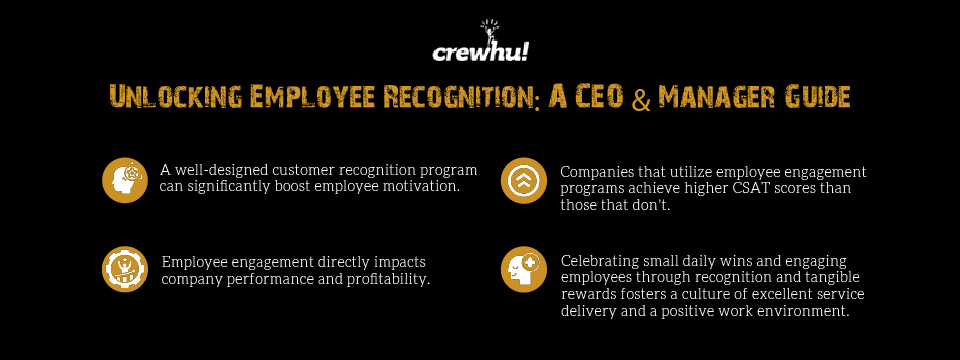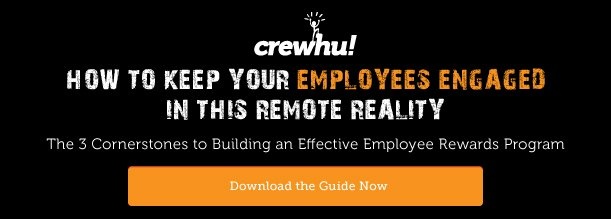Unlocking Employee Recognition: A CEO & Manager Guide

How to elevate employee engagement and drive organizational success with strategic incentive programs.

In a business environment where brand reputation is more fragile than ever, CEOs and managers need to pay close attention to the human factors that drive their companies. Employee satisfaction and work engagement are more than just HR buzzwords, they’re critical indicators that directly impact your bottom line.
A report by Gallup underscores this, showing that companies with the most engaged employees are 21% more profitable than those with the least engaged employees. This emotional engagement isn’t just about feeling good; it’s about the level of effort employees are willing to invest in their work.
This guide aims to provide CEOs and managers with science-backed strategies to improve employee satisfaction and engagement. And one of the best ways to do that is by implementing effective incentive programs.
Theories of motivation and incentives
Understanding the psychology behind motivation is crucial for designing effective incentive programs. Let's delve into some key theories that can guide CEOs and managers in this endeavor.
Intrinsic vs. extrinsic motivation
Motivation isn’t a one-size-fits-all concept; it comes in two main flavors: intrinsic and extrinsic. Intrinsic motivation is fueled by enjoyment or personal satisfaction derived from the task itself. Extrinsic motivation, on the other hand, is driven by external rewards. Intriguingly, research shows that not all actions are fueled by the promise of external rewards. Sometimes, the action itself is the reward, especially for tasks that resonate on a personal or meaningful level.
Operant conditioning and reinforcement principles
Operant conditioning, a theory pioneered by B.F. Skinner, posits that behavior is shaped by its consequences – rewards or punishments. This is why positive reinforcement can be so effective in encouraging employees to replicate desired behaviors. For instance, if an employee lands a bonus for wrapping up a project ahead of schedule, you can bet they’ll be gunning for efficiency in their next assignment.
Armed with these insights, CEOs and managers are better equipped to design incentive programs that tap into the diverse motivational triggers of their employees, making for more engaged and productive crews.
The neuroscience of motivation
Ever wonder why some rewards feel so good? It’s all about the brain’s reward pathways and the neurotransmitter dopamine. When we receive a reward, our brains release a certain amount of this feel-good chemical – and if the reward is greater than anticipated, the level of dopamine increases. This dopamine surge amplifies our motivation to repeat the behavior, explaining why well-designed incentive programs can be incredibly effective.
It turns out that rewards do more than just trigger a dopamine release; they also spark positive emotional responses. This emotional uplift not only boosts work engagement but also elevates overall job satisfaction. Over time, this emotional commitment from employees can ripple out to create higher customer satisfaction and fortify your brand’s reputation.
Building a recognition-based culture
It takes more than just a paycheck to build a motivated crew. A culture that celebrates recognition is vital for long-term success. For starters, your incentive programs should align seamlessly with your company’s core values and objectives. This ensures that rewards go beyond the financial and foster your crew’s personal and professional growth.
Of course, it’s not just about making life better for your employees. Crafting impactful incentive strategies will not only elevate employee satisfaction and engagement but will also fortify your brand's reputation and increase customer satisfaction. In fact, survey data collected by Crewhu found that MSPs who use CSAT and employee recognition programs score an average of 5 points higher than their competitors who use only CSAT.
Of course, it’s pretty self-evident that engaged, motivated employees provide better customer service, but the effects can be more subtle than that. How many times have you walked into a business and immediately sensed that everyone there is miserable? Customers and prospects pick up “vibes” from your employees, and they’ll have a more favorable view of your company if your employees are giving off good vibes.
Recognizing and rewarding employees isn’t a luxury, then. It’s a strategic imperative for any organization aiming for the pinnacle of success. So, if you’re a CEO or manager looking to improve your brand reputation, start by looking inward at your most valuable asset – your employees.
Elevate your employee engagement and customer satisfaction with Crewhu
It’s not difficult to see that employee recognition isn’t just some feel-good buzzword, it's a must-have for any organization that wants to boost its brand – and its bottom line. By understanding the theories and neuroscience behind motivation and rewards, companies can build more effective, science-backed incentive programs that benefit both employees and the organization.
But why go to the trouble of designing an effective employee recognition program yourself when the experts at Crewhu have already done the heavy lifting for you? Our state-of-the-art gamification platform can provide incentive programs that integrate seamlessly into your company culture and drive your employees to new levels of satisfaction and engagement. Dive deeper into our research-based strategies by scheduling a consultation with our crew today!
Topics: employee satisfaction, actionableinsights, employeeengagement, crewhu, organizationalsuccess, incentiveprograms, strategicmanagement, workplaceculture, employeeretention, sciencebackedstrategies, businessleaders, work engagement







